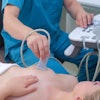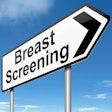
VIENNA - Although there has not been any organized mammography screening in Austria to date, breast cancer mortality has significantly decreased since the 1990s. With the exception of some local pilot projects, early breast cancer detection has depended upon opportunistic breast cancer screening in individual radiology practices.
 Dr. Oswald Graf from Steyr, Austria.
Dr. Oswald Graf from Steyr, Austria.
In October 2013, organized mammography screening will be introduced in Austria, utilizing the robust existing infrastructure of local radiology practices. Performing screening exams in locations distributed all over the country should help achieve high rates of participation among the female population. Participating institutions will have to meet specific qualifications, similar to those in other European countries.
Women ages 45 to 69 years will receive an invitation for screening; women ages 40 to 44 years and 70 to 75 years may opt in for screening. Invitations for screening and evaluation of the entire program will be carried out using central data management, provided by government healthcare authorities.
The upcoming Austrian National Screening Programme will have some specific features. Only digital mammography equipment will be used, and, in addition to mammography, ultrasound will be added as an adjunct test in women with dense breast tissue. This approach is supported by multiple studies, amongst them the very strong multicenter American College of Radiology Imaging Network (ACRIN) 6666 study, which showed that ultrasound is able to find a significant number of invasive cancers in dense breasts, which would otherwise remain undetected with mammography.
In Austria, ultrasound has been widely used for opportunistic breast cancer screening in the past, and radiologists are quite experienced using this technique. However, the impact of supplemental ultrasound for early detection has not been systematically evaluated throughout the country. The practice of double reading screening mammograms -- intended to reduce the number of false-negative results due to human error, and widely used in many other countries -- has only been applied in some Austrian institutions.
The first ever screening program of its kind, the Austrian National Screening Programme will see mammography carried out alongside ultrasound in women with dense breasts by the first-line radiologist. A second reading of the mammograms will be performed by another radiologist. Despite the limited value of mammography in dense breasts, as well as the influence of human errors in reading screening mammograms, the combined approach should increase the overall sensitivity for early breast cancer detection.
This combined approach is a major logistical and scientific challenge. Most Austrian radiology practices in remote areas only have one radiologist, with groups of radiologists found mainly in larger urban areas. Therefore, the process of double reading requires some logistical effort. Teleradiology networking should facilitate the double reading process and help compensate for the shortage of radiologists, which is a familiar problem in many other European countries.
Austrian radiologists are very well aware of the fact that we are pioneering new methods in breast cancer screening and that our experience may serve as a pilot project for screening programs in other countries.
Dr. Oswald Graf from Steyr, Austria, heads the Breast Imaging Task Force at the österreichische Röntgengesellschaft (ÖRG). More information about the ÖRG can be found at www.oerg.at.
Originally published in ECR Today on 7 March 2013.
Copyright © 2013 European Society of Radiology



















